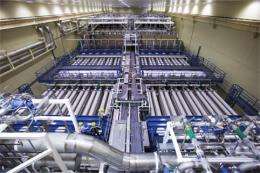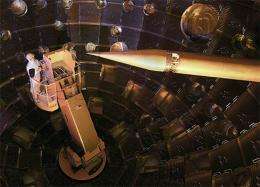Laser Bay 2, one of NIF's two laser bays
(PhysOrg.com) -- The National Ignition Facility (NIF) at Lawrence Livermore National Laboratory in California has set a new record for a laser shot. This past week, its combined 192 lasers fired a single 1.875-megajoule shot into an empty test chamber. After passing through the last of its focusing lens, the shot reached 2.03 megajoules, making it the first 2 megajoule ultraviolet laser.
Prior to this achievement, the most the facility had managed to coax out of the laser, the world’s largest, was 1.6 megajoules. Also, the new record shows that the NIF laser is capable of producing more than it was designed for, which was 1.8 megajoules. It also proved that it was capable of doing so without damaging its parts, allowing for another shot a day and a half later, which is important, because one of the goals for the laser is to get it to fire off shots at 15 per second eventually. That’s what researchers think will be needed to produce power economically from the laser system.
The ultimate goal of the NIF is to figure out a way to use a laser to produce nuclear fusion in a way that gets more energy out than is put in. Currently, that goal is still a ways off. Thus far, engineers at the project haven't even reached the break-even or ignition point, though they expect that to occur sometime this year. Tweaking the laser to produce more than it was designed for is a step in that direction. The NIF facility was designed to produce a fusion reaction by imploding hydrogen isotope pellets using the huge laser. To that end, the team has made steady progress. When the project first began eighteen months ago, it had just one percent of conditions in place that are believed necessary to achieve the ignition point. They have improved that mark to ten percent and it’s because the pace has picked up dramatically in recent months that they believe they will achieve the ignition point sometime over the next six months, which is when the original ignition campaign was slated to end.
Technicians adjust the target positioner inside the NIF Target Chamber.
Because the facility is funded by the US nuclear weapons complex, there has been debate about whether it would ever be used to prove or disprove the idea that lasers could be used to create nuclear fusion to produce electric power. Having the laser break records doesn’t really resolve that argument in the short term, but it might in the long run if it does eventually show that electricity could be created economically using such a process.
More information: The National Ignition Facility (NIF): lasers.llnl.gov/
An official announcement is below:
The National Ignition Facility (NIF), the world's most energetic laser, surpassed a critical milestone in its efforts to meet one of modern science's greatest challenges: achieving fusion ignition and energy gain in a laboratory setting. NIF's 192 lasers fired in perfect unison, delivering a record 1.875 million joules (MJ) of ultraviolet laser light to the facility's target chamber center.
This historic laser shot involved a shaped pulse of energy 23 billionths of a second long that generated 411 trillion watts (TW) of peak power (1,000 times more than the United States uses at any instant in time).
The record-breaking shot was made March 15.
"This event marks a key milestone in the National Ignition Campaign's drive toward fusion ignition," said NIF Director Edward Moses. "While there have been many demonstrations of similar equivalent energy performance on individual beams or quads during the completion of the NIF project, this is the first time the full complement of 192 beams has operated at this sound barrier."
The ultraviolet energy produced by NIF (after conversion from the original infrared laser pulse to the final ultraviolet light) was 2.03 MJ before passing through diagnostic instruments and other optics on the way to the target chamber. As a result, NIF, located at Lawrence Livermore National Laboratory, is now the world's first 2 MJ ultraviolet laser, generating nearly 100 times more energy than any other laser in operation.
Satisfying the NIF objective coincides with the third anniversary of the startup of NIF operations in March 2009, when 1 MJ operation was first achieved. Since then, NIF has increased its operational energy about 1 kilojoule each day for three years, a remarkable achievement. Today, NIF is fully operational around the clock, completing important steps toward the goal of ignition and providing experimental access to national and international user communities.
The 1.875 MJ shot exceeds NIF's original design specification and sets the stage for full-power experiments over the coming months. Not only did the shot achieve the highest recorded energy threshold, it also was one of the most precise ever fired at NIF: The energy produced was within 1.3 percent of its goal. Such precision is vital because the energy distribution among the beams determines how symmetrical an implosion is obtained in capsules containing fusion fuel. Implosion symmetry is a critical factor in achieving the pressures and temperatures required for ignition. Moses said that NIF will pursue operations at even higher power and higher energy levels to achieve ignition.
"Our facility's ability to demonstrate this level of precision performance as part of routine operations is a testament to the efforts of multiple teams supporting laser operations, target chamber operations, transport and handling and optics refurbishment," Moses said.
"For the past 15 years, since NIF groundbreaking in 1997, the scientific community has regarded the 1.8 MJ milestone as a tremendous technical challenge," said NIF Operations Manager Bruno Van Wonterghem. "In 2003, we demonstrated this performance level on a single beam line, and in 2008 we repeated the demonstration on a single quad of four beams. To achieve this performance level with this kind of precision, quality and reliability on all 192 beams is unprecedented and very exciting."
Van Wonterghem points in particular to the enormous progress NIF scientists and engineers have made in economically maintaining the facility's optics system while operating at unprecedented energy levels.
© 2011 PhysOrg.com
























